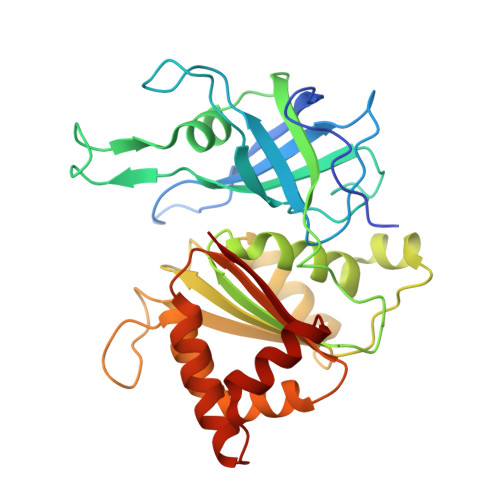Role of Specific Residues in Coenzyme Binding, Charge-Transfer Complex Formation, and Catalysis in Anabaena Ferredoxin Nadp(+)-Reductase.
Peregrina, J.R., Sanchez-Azqueta, A., Herguedas, B., Martinez-Julvez, M., Medina, M.(2010) Biochim Biophys Acta 1797: 1638
- PubMed: 20471952
- DOI: https://doi.org/10.1016/j.bbabio.2010.05.006
- Primary Citation of Related Structures:
2X3U - PubMed Abstract:
Two transient charge-transfer complexes (CTC) form prior and upon hydride transfer (HT) in the reversible reaction of the FAD-dependent ferredoxin-NADP+ reductase (FNR) with NADP+/H, FNR(ox)-NADPH (CTC-1), and FNR(rd)-NADP+ (CTC-2). Spectral properties of both CTCs, as well as the corresponding interconversion HT rates, are here reported for several Anabaena FNR site-directed mutants. The need for an adequate initial interaction between the 2'P-AMP portion of NADP+/H and FNR that provides subsequent conformational changes leading to CTC formation is further confirmed. Stronger interactions between the isoalloxazine and nicotinamide rings might relate with faster HT processes, but exceptions are found upon distortion of the active centre. Thus, within the analyzed FNR variants, there is no strict correlation between the stability of the transient CTCs formation and the rate of the subsequent HT. Kinetic isotope effects suggest that, while in the WT, vibrational enhanced modulation of the active site contributes to the tunnel probability of HT; complexes of some of the active site mutants with the coenzyme hardly allow the relative movement of isoalloxazine and nicotinamide rings along the HT reaction. The architecture of the WT FNR active site precisely contributes to reduce the stacking probability between the isoalloxazine and nicotinamide rings in the catalytically competent complex, modulating the angle and distance between the N5 of the FAD isoalloxazine and the C4 of the coenzyme nicotinamide to values that ensure efficient HT processes.
Organizational Affiliation:
Departamento de Bioquímica y Biología Molecular y Celular, Facultad de Ciencias, and Institute of Biocomputation and Physics of Complex Systems (BIFI), Universidad de Zaragoza, E-50009 Zaragoza, Spain.

















